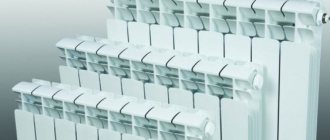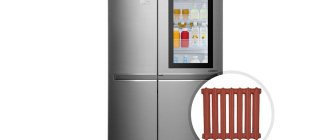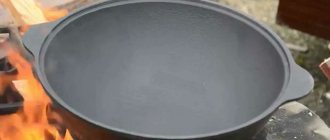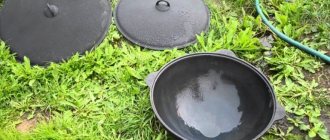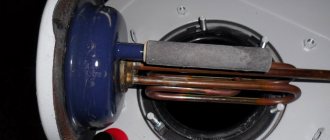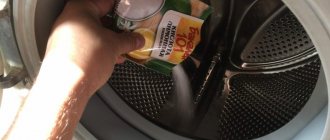Algorithm for cleaning the radiator
- We remove all unnecessary things and furniture from the heating radiator that may interfere with or delay flushing. If there are curtains hanging near it, you need to remove them. In addition, if the room uses laminate or parquet as flooring, then it is necessary to spread some piece of fabric or film under the radiator - this is done so as not to harm the floor.
Before starting work, you must turn off all taps
It is necessary to shut off the water supply to the radiator. If there is no shut-off valve that allows this to be done, then you will have to go the other way - drain the water from the heating system. Take a regular bucket, remove the radiator by unscrewing it from the rest of the equipment, and drain the water present in it into the prepared bucket. The cleaning process is just beginning and then you need to take the heating radiator to the bathroom and then place it in the bathtub. There is a risk of causing mechanical damage to it in the form of scratches, and in order to prevent such a development of events, place something like a wooden pallet under the radiator. If you live in a private house and not in an apartment, then to flush the radiator you will need to take it out into the yard.
The end fittings are unscrewed using a wrench
We unscrew the end fittings using a wrench. This must be done in the yard or in the bathroom, otherwise you can fill the floor with a cloudy and littered liquid that has a very unpleasant odor, and you will create another problem for yourself - you will need to clean the floor.
Next, you need to rinse the heating radiator from the inside; to do this, we supply water under pressure from a hose or shower into the holes at the end.
- Sometimes owners are forced to deal with crystalline blockages, and in this case slightly different means are needed. You can't do without a concentrated vinegar solution. We install the end fittings at the bottom and pour vinegar inside. Before using vinegar, it is recommended to dilute it 70% with water. This flushing will help remove stubborn blockages from the heating radiator. The solution should sit for about two hours, after which it should be poured out and the radiator should be cleaned with water pressure to achieve complete cleansing.
- You can also wash the external surfaces of the radiator to give it a nice and clean look.
One of the reasons for clogging may be scale formation
The radiator should be placed on wall mounts and the threaded connections on it should be lightly cleaned with a cloth, which must be dry. If you have a cast iron radiator, then screw tow onto all the fittings in the direction of the threads and apply paint to the seal. It is allowed to use any paint related to “Nitro” and “Enamel”. Using a two-piece gas wrench, tighten the fittings tightly. If the apartment has more modern radiators, then it is recommended to use film for waterproofing purposes. Do not use tow or paint.
So, as we see, there is nothing overly complicated about cleaning the radiator. This will not require any special skills or knowledge, just as you will not need any rare means and tools that are difficult to obtain. If done responsibly, this procedure will not take too much time and effort, and therefore every owner can clean the radiator on their own. However, there are situations where even after all the measures have been taken and the radiators are installed in their place, the heating system still functions poorly. In this case, you need to buy a new radiator and replace the old one, or use the services of specialized companies that carry out cleaning with a technical booster.
Preparing for work
If you don’t want to run through authorities and pay a lot of money for services, you need to know how to clean cast iron batteries yourself. In principle, there is nothing complicated in this process if you devote a little time and effort to it.
As with any other business, preparatory work will be required. They are as follows:
- If washing is carried out in an apartment, then it is necessary to prepare the bathroom . To do this, it is better to place a grate on its bottom and cover the walls with a rag. If there is no pallet, then you can use the same rags, only in a thicker layer. This will protect the container from damage and protect the enamel coating. You also need to cover the drain with a fine mesh to prevent debris from getting into the water pipes.
- All water must be drained from the heating system, having first been disconnected from the main communication.
- The threaded clamps are removed from each battery using an adjustable wrench.
- Plugs must be placed in the pipes at the removal site.
When disconnecting the radiator from the heating network pipe, you should substitute a container in advance, since water may remain in it, just like in the heater itself.
The further task is how to rinse the inside of the cast-iron battery under running water in a bathtub. There are both special and “folk” means for this.
Basic technology and sequence for flushing heating radiators
If you decide to flush the heating radiator yourself, then you will need a simple set of tools necessary for dismantling and installing the radiator, rags and a cast-iron bathtub. If you have an acrylic or cast iron bathtub installed, but have the opportunity to do it outside, you are incredibly lucky. In the case of a cast iron bathtub, everything is done in the following sequence:
- we remove the heating radiator - unfortunately, this is a necessary measure;
- we line the bottom of the bathroom with unnecessary rags to protect the enamel from damage, also for the safety of the sewer system, we install a mesh on the drain, which will protect the sewer from washed-out solid particles getting into it;
- we disassemble the mixer by removing the watering can from it, because for this procedure we need concentrated water pressure;
- We start flushing the radiator. To achieve the best effect, it must be turned periodically.
When flushing the radiator, you may have to additionally remove solid particles that need to be pushed through with a wire specially prepared for this purpose or other available means. Thus, it is necessary to flush the radiator until it is completely clean. This will be indicated by the clean water that will flow from them. As for washing on the street, to do this you need to extend a hose with water and do everything in the same sequence. Naturally, after washing the internal surface, it is necessary to clean the radiator from the outside, giving it an aesthetic appearance.
Very good results can be achieved by using special devices for flushing radiators. In this case, dismantling the radiators is not required. However, this method has a significant drawback - the high cost of equipment, which, given the infrequent work on flushing the radiator, is impractical to buy. Such devices are often used by utility services or construction companies, which have to deal with a similar problem quite often.
Flushing radiators using special equipment - video
If it happens that none of these methods suits you and rinsing with running water is impossible, you can do it differently. To do this, simply pour hot water into the radiator and add a cleaning agent; it is better to use soda ash for this. After about an hour, tap the radiator with a wooden hammer, drain the water and repeat this procedure several more times until it is completely clean. You can also use liquid for washing car radiators and whey for this, but such methods are used much less frequently.
Cleaning process
Whatever cleaning agent is chosen for cast iron radiators, the washing procedure looks the same. How to wash cast iron radiators at home? To work with simple means you need to go through several steps:
First, you should free the radiator from the plugs and wash out all the dirt from it with plain water under pressure. It’s good if there is a water supply or a well with a tap. If not, then you can use a large-volume container and a deep-well pump
It doesn’t matter in what way, but pressure must be created. Next, you need to plug the radiator on three sides, and fill the internal cavities through the fourth hole with a solution of any caustic-based product. Place the liner in place and let it sit for a while with constant shaking of the radiator.
Caustic soda will rid the battery of organic dirt. Empty the device from liquid and, in the same way, fill in the citric acid solution. It is better to make this composition hot, so it will act on the sediment faster and more effectively and dissolve it. The radiator should be left in this state for three to four hours. But not at rest, it needs to be moved periodically. After the specified time, the solution must be drained and the battery lightly tapped on all sides. The plaque, softened under the influence of acid, will detach from the cast iron surface. It can be washed with plain water. Rinsing must be done until clean water flows from the battery.
In particularly difficult cases, when flushing the assembled radiator does not give the desired result, it is disassembled into separate sections. Cleaning is carried out one by one for each part separately. Only when reassembling it is recommended not to use old intersection gaskets; they must be replaced with new ones.
Ready solutions
GEB G30 Desembuant
The product can be used not only in metal, but also in plastic pipelines. 1 liter of solution is designed for 100 liters of coolant.
Price: $14.
GEB G30 Desembuant
pros
- suitable for plastic pipes;
- compatible with underfloor heating systems;
- small expenditure of funds.
Minuses
high price.
HeatGUARDEX Cleaner 808R
A product based on hydrochloric acid is designed to combat long-term deposits older than 3 years. The manufacturer promises that flushing with the drug will extend the life of the heating system by 10 years. 1 liter of the drug is designed for 100 liters of coolant.
Price: 3990 rub./l.
HeatGUARDEX Cleaner 808R
pros
- easy to use;
- effective in combating heavy pollution.
Minuses
not identified.
Filter materials for water treatment systems HeatGUARDEX Cleaner 808R
How to clean an aluminum radiator
Use of chemicals
Aluminum is an extremely capricious metal. When choosing what and how to rinse aluminum radiators, you need to focus exclusively on the product whose composition will affect the deposits without affecting the walls themselves.
Chemical washing is good because it does not require dismantling the batteries and can be carried out even at the height of the heating season.
It is based on 2 stages of work:
- Dissolving scale.
- Flushing and removing them from the system.
The disadvantages of this type of cleaning include the increased toxicity of chemicals. When carrying out this procedure, you need to use protective measures and be very careful.
Attention is also required when diluting a chemical composition if it is sold as a concentrate. An incorrect proportion can destroy aluminum along with scale.
The most popular is the Master Boiler Power concentrate, which is suitable for all types of pipes and radiators. You can also use “folk” remedies, for example, vinegar, whey or caustic soda.
Find out useful information about aluminum batteries on our website:
Hydrodynamic flushing
This is one of the most labor-intensive ways to clean a heating system. It is based on a shock jet of water, under the pressure of which the scale peels off the walls of the radiator.
Sequence of work:
- The carrier is completely drained from the line.
- Areas that need to be washed are identified.
- Part of the pipe is removed, and in its place a hose with a special nozzle is connected, the end of which is inserted into the main line.
- Water under the action of a pump under high pressure is supplied to the radiator, sweeping away scale and all debris along the way.
After the cleaning is completed, the system should be filled with water and run through it several times to remove scale removed from the walls of the radiator.
Hydraulic flushing
This work can be carried out during the heating season, since it only requires running water through the system:
- Before starting work, a hose is connected to the drain valve, the second end of which is discharged into the drainage sewer system.
- The tap on the supply side opens and the layer of dirt disappears under the flow of incoming water.
- Cleaning can be considered complete once clean water flows through the system.
This method is used for regular cleaning of batteries. If the system has not been cleaned for a long time and the contamination is strong enough, it will not help.
Pulse washing
If the question is asked how to clean an aluminum heating radiator with minimal risk to it, then the answer is clear - using pulse washing.
This is a fairly “young” and progressive method that guarantees safety for the aluminum walls of heaters, but it requires special devices, so calling in specialists is indispensable.
The method is based on a short-term pulse effect on water, during which a shock wave is formed that moves through the system under a pressure of 12 atmospheres. This allows you to remove scale of any thickness without damaging the walls of the radiator, provided that it can withstand such water hammer.
This method is effective if:
- The diameter of the pipes does not exceed 4 inches.
- Even 60 m away from the device that creates the pulse effect, radiators are effectively cleaned of scale.
- Pulses do not affect the integrity of fittings and line components.
This flushing method increases the efficiency of the radiator by up to 25%, which practically returns the design to the parameters corresponding to the product that has just left the factory assembly line.
Chemical wash
There are only two cases in which this washing method can be used.
- If it is necessary to remove blockages in a natural circulation system that uses steel pipes. This is advisable when, for one reason or another, you do not want to completely change the system. The predominant part of the blockage is formed in the heat exchangers, if we are talking about deposits. Siltation occurs along the entire perimeter of the system, settling more at the bottom.
- If you need to resuscitate a heating system that has been operating for decades. The pipes gradually become overgrown and silted, resulting in reduced heating efficiency.
Video
Important information! If the pipes are old and not galvanized, then you will hardly notice the result of washing. The chemicals will dissolve the rust and new leaks will appear after the procedure.
In fact, the flushing procedure is extremely simple: instead of water, a special chemical composition is poured into the system, which includes alkali and acid. Next, the composition continuously circulates in the system for a couple of hours, then it is drained and plain water is refilled.
Such a chemical is not cheap - about 6,000 rubles for a twenty-five-liter canister. According to SNiP, this solution cannot be poured down the drain after use. At the same time, there are special neutralizing compounds on sale in case there is nowhere to put the used solution.
Important information! This solution must NOT be used for aluminum pipes, since the latter will last significantly less after washing!
Tools for disassembling a cast iron device
Their list consists of:
- Radiator key.
- Chisels.
- Hammer.
- A small sledgehammer.
- Brushes with metal bristles.
- Blowtorch.
- Plumbing wrench No. 2,3. They need to unscrew the side plugs or plugs.
In many cases there is no radiator key. The situation is complicated by the fact that it is almost impossible to find in construction stores. Of course, it exists in the markets. Also, plumbers must have such a key.
The key itself is a round metal bar. which is 18 mm in diameter. One end is flattened and resembles a spatula. It has dimensions 28x40 mm. Thickness 6 mm. At the other end there is a welded ring. You need to insert a lever into it. As for the length of the key, it should exceed half the length of the radiator by 30 cm.
You also need to prepare several boards. Chocks may be suitable instead. They will be fitted with a battery before disassembly.
Flushing heating radiators made of cast iron, specifics and cleaning methods
In this publication we will talk about the ways in which you can wash outdated cast iron heating batteries. One of the good qualities of good cast iron radiators is considered to be a reliable service life. However, such a circumstance as blockage of heating devices leads to worse heating of the room.
Several factors influence battery clogging. But the main one is considered to be the occurrence of rust due to drainage of water from the heating system in the summer and poor quality of the coolant.
If the heating temperature of the heating pipes is very high, critically dirty heating devices will produce an extremely low heat rating. To eliminate this, it is necessary to carry out preventive measures at 15-20 years to clean heating devices from all kinds of contaminants.
Taking preventative measures to clean a multi-section cast iron radiator is not difficult, but not everyone can lift and dismantle the design of the radiator on their own. An excellent option would be to carry out this work with a plumber or assistant.
Another way out of the situation: disassemble the cast-iron sectional heating device into very small parts. In such a case, cleaning the radiator will not cause problems.
If the cleaning work will take place in a building with several apartments with centralized heating, you must make sure that the heating system is not turned on during the implementation of preventive measures. In a private house outside the city, a sufficient requirement would be to familiarize yourself with the weather forecast for the next few hours or days.
Basically, soda ash dissolved in hot water is used to clean the battery. To prevent the solution from spilling out of the heating device, it is necessary to install specialized plugs at the ends of the radiator. Moreover, you need to shake the battery a little and leave it for about an hour.
Another stage consists of tapping all sections of the heating device with a wooden hammer (mallet). This is necessary to separate rust and growths that have peeled off due to the action of soda ash from the surface inside the heating unit. Then you should remove one of the foot plugs and replace it with a rubber hose connected to the water meter unit. Next you need to remove the second plug. The tap of the water meter unit must be fully opened to create a powerful stream of water that will wash out all the debris from the heating device.
If you use a compressor to carry out this procedure, the efficiency of the work process will be increased. The soda ash solution can definitely be replaced with ordinary whey from milk, which also helps to peel off all kinds of contaminants in the middle of the heating device.
Soda ash can also be replaced with a liquid or cleaner for a car heater. But in this case, you will have to carefully study the instructions in order to correctly calculate the required dosage according to the volume of the heating device.
From the very beginning, liquid is poured into the radiator design to flush cast iron heating radiators, then hot water is added there. The battery needs to be kept in this state for about 2 hours, but every 10 minutes you will have to magically move the parts. At the end of 2 hours, the cast iron sectional heating device must be thoroughly washed using a flexible hose and running water.
To keep the heating device clean, you can use a trick and install an outlet with a plug in front of the inlet. In such a case, rust particles will attach to the magnet installed on the outside. Let's watch the video. Thanks to such actions, all dirt and corrosion will be attracted to a specific place and will not enter the battery. Of course, a similar plug must sometimes be cleaned and put back. But the measures taken in the future will prevent the entire battery from being cleaned.
Outside
How to rinse cast iron radiators, as well as all others? You can clean up the outside of the radiator using several methods - it all depends on the degree of contamination.
Dry cleansing
Everything we cover here is more suitable for everyday cleaning. For general purposes, more serious methods are needed. So, there are two simple and effective ways:
- Using a vacuum cleaner. It’s very good if you have special attachments - because the battery sections are sometimes very close to each other, so you can’t get to them with a regular floor brush.
- Using a hair dryer. In this case, a damp cloth of suitable size is attached between the wall and the radiator. Air from the device simply blows dust between the battery sections onto this cloth. Then it remains to carefully remove the material and rinse it from dust.
Wet cleansing
How to clean a heating battery when it is very dirty? If you want to do high-quality spring cleaning, then this is the place for you. First of all, we focus on the degree of contamination of the radiator:
Light to medium soiling. Before wet cleaning, it is best to carry out dry cleaning, which we described above. It is advisable to use hot water, even boiling water. Be sure to find a container of suitable size that can be placed under the entire duration of the battery - water will flow into it
Then, from another container, carefully pour boiling water over the battery, section by section. After the water has drained from it, it is additionally dried with prepared rags, napkins
Washing areas between sections. To ensure that wet cleaning reaches areas between sections that we physically cannot reach with our hands, it is best to use a steam mop (pictured). Some housewives additionally spread cotton napkins for better steam absorption. As an option, you can wrap a rag around a pointer, a stick, a narrow handle, or a nozzle for something and, moistening it in water, clean hard-to-reach areas.
Heavy contamination. Anti-fat agents are used. An aqueous solution is first prepared from them, which is poured into a spray bottle or spray bottle and thoroughly sprayed over a moistened battery. Then some time is given to “acidify”. After which the cleaning solution is completely removed with water and rags from the surface of the battery.
Battery cleaning brushes and sponges
To remove old stains, the following will help:
- A toothbrush, brush or narrow paint brush with stiff bristles. They are able to crawl into the most remote corners of the radiator.
- Sponge. If you attach it to a long ruler, it can also clean hard-to-reach places.
- Rubber glove. You need to put it on your hand and wash it well with laundry soap. Then rub off stubborn stains on the heater using your fingers. Can be replaced with old cut-off tights or socks.
- Dishwashing brush. Use this brush to clean the battery. They are sold in hardware stores and have a comfortable long handle.
- Spray. In order to wash the inside of old batteries, you need to add detergent to the spray bottle and spray the dirt. Wait a while and wipe the soaked areas with a damp cloth.
Before using cleaning chemicals, you should carefully read the composition. Since it may contain aggressive active substances that can easily destroy the surface of the radiator.
Radiator cleaning
Let's imagine what the cleaning procedure will look like under different conditions.
Washing with a special device
To quickly and effectively clean radiators “without leaving the cash register,” there are special devices for washing them. Of course, having such a device for infrequent cleaning of a home battery is essentially a luxury.
The device operates from the mains - it drives water into the radiator with a powerful jet, which with its pressure removes scale, rust, grease, and various chemical deposits. But if you don’t have this device, you can replace it by cleaning the radiator in the bathtub.
Washing algorithm in the bath
How to wash batteries in an apartment without being able to take them outside? The instructions will consist of the following blocks:
- Filling with hot water. You will need to use a hose, shower, watering can, kettle with a narrow spout, or a regular funnel to pour hot water inside the radiator. Open both plugs to allow dirty water to flow out freely. Once there is enough liquid in the battery, shake it and pour out all the contents. The action should be repeated until large pieces of dirt fly out of the radiator being cleaned. It is worth noting that the procedure is difficult to perform alone - the weight of the battery is significant even for a brave athlete. Therefore, 1-2 assistants in this matter are vital for you.
Pouring cleaning agent. The second step is to pour the cleaning agent you have already chosen into the radiator, diluting it with water
Now it is important to put plugs on all the holes in the battery so that the “useful liquid” does not leak out of it. Depending on the drug, it is left to “acidify” for a period of 2 hours. As soon as the active component has expired, you need to shake the radiator again
You can knock on its various parts with a wooden, plastic, or rubber hammer. This will help further remove rust and other contaminants from its internal parts.
Now it is important to thoroughly rinse the cleaning agent. Therefore, it is necessary to clean until the foam stops coming out, the smell stops being felt, or other characteristic features of its presence are manifested in some other way.
If you do not rinse the radiator completely, the active components of the product will continue to act, destroying the metal from the inside, which will cause leakage and failure of the battery.
The videos in this article will show you how to clearly follow the instructions.
Features of cleaning in a private home
Cleaning batteries in your homes is even more important than in apartments. This is due to a number of heating features:
- The coolant is water from a well, borehole, or even a reservoir. Hence, there is more coarse dirt stuck in the radiator than in the water circulating through the lines of city heating systems. Therefore, the need for cleaning arises much more often.
- Not only the radiator is washed (blown), but also the heating main. After all, all the debris stuck in it will invariably end up in the cleaned battery.
- In case of urgent need, you can clean the radiator during the heating season. Otherwise, during the cold season, it makes no sense to turn off the heating system for cleaning.
Features of flushing during the heating season
If you decide to clean the battery during the cold season, then pay attention to the following:
- The cleaning method and detergents are the same.
- It is possible to flush radiators (in a private house) without removing them and without draining the water from the heating boiler:
- Disconnect the steam line completely while cleaning.
- Perform a purge.
- Put all the valves back on, and then run water through the thermal circuit.
- Feed it until absolutely clean water flows out of the pipeline.
The measures taken will clean not only the radiator, but also the entire heating line in general.
Thus, cleaning the radiator without removing it is only possible in your own home. Residents of apartments will have to remove it to clean the battery from the inside. An exception is for those who have a special device for cleaning batteries.
Causes of pollution
In centralized heating systems, very little control is exercised over the condition and quality of the coolant. The water circulating through the network contains a large amount of foreign impurities. The pipes in some areas are old and, as a result, corroded. Under the pressure of hot water, rust particles break off from the surface of the pipes, enter the radiators and settle on their walls.
Rust and impurities gradually clog the channels, the volume of coolant moving through them is reduced and, accordingly, the room is heated with less efficiency.
Today on the heating equipment market you can find radiators made of a variety of materials: steel, bimetal, cast iron, aluminum, etc.
Steel batteries are the cheapest, but at the same time quite effective. Cast iron is a traditional material that has been used since ancient times. Will be a great element in retro style.
The cleaning method and the material from which the radiator is made are not related to each other. However, to flush bimetallic batteries, it is recommended to use a composition based on chemical components.
How to disassemble a cast iron radiator
The joints of the old battery are quite strong. In many cases, they “grow together” in such a way that strength alone is not enough. Therefore, before disassembling the battery, it should be placed on boards and properly prepared.
The simplest preparation involves heating the joint. To do this, use a hair dryer or a blowtorch. The latter can burn old paint. However, it's not scary.
More serious preparation involves heating the metal to such an extent that it begins to glow. After this they try to unscrew the nipple. This can be done both when the alloy becomes very hot, and when it has cooled noticeably. The second option is even better, because during cooling the gasket becomes covered with cracks and the strength of the connection becomes weak. He is often shown in videos.
To disassemble a battery made of cast iron, you need to perform the following steps:
- Unscrew the plugs (plugs).
- Place the radiator key on top of the device so that the flattened end rests on the nipple. Make a mark on the key where the battery ends using chalk or electrical tape.
- Insert the key inside the bottom hole.
- Turning it along the axis to the right and left, insert it into the product up to the drawn mark.
- Determine which way the nipple is screwed. To do this, bait it with the right and left sides. If you manage to bait it with the right side, then you need to unscrew it counterclockwise.
- If you manage to move the nipple, then make one revolution. Next, a similar procedure is done with the nipple at the other end of the section.
- Both nipple nuts are unscrewed in turn. Otherwise the section will crack.
- In the same way, you need to unscrew all sections.
If it was not possible to disassemble the heating battery in this way, you will have to saw through the section that is leaking. At the same time, they saw it in the center of the nipple. The work is carried out by picking up a grinder or a hacksaw.
Another option is to break the bad section with a sledgehammer. You need to break the middle part of the section. The nipple, which remains unharmed, is unscrewed using a plumbing wrench. It can also be knocked out using a hammer and chisel. Then you need to clean the threads in entire sections.
Heat meter for a battery How to choose a solar battery for your home Screens for a heating battery Which heat regulator can be installed on a battery
Cleaning batteries using special equipment
Cleaning cast iron batteries without removing them can be done using special equipment. The following complex equipment is intended for domestic needs:
- pneumatic pistol "Typhoon";
- device for electrohydropulse influence ZEVS-24;
- cleaning device Krot-Mini.
Air pistol "Typhoon"
Flushing the battery with a Typhoon pneumatic gun
The equipment is compact and easy to use. It is used to perform targeted impact on blockages in water and sewer pipes with a diameter of up to 150 mm. The essence of the process is a hydraulic ram to remove hardened deposits from the walls of equipment and adjacent risers with a shock wave at a speed of 1.5 km/h, which spreads over a distance of up to 60 meters.
Pneumatic pistol "Typhoon" in action
This cleaning of the heating system allows you to completely remove contaminants that are not amenable to conventional hydraulic flushing.
"Typhoon" is indispensable as a plumber's tool for clearing blockages in various hard-to-reach places. Depending on the configuration and weight, the device has 6 modifications and the following indicators:
- internal cleaning diameter up to 150 mm;
- maximum firing range to the target is 60 m;
- special valve design for kinetic ramming;
- pressure gauge on the body;
- Possibility of manual inflation.
Comprehensive flushing of heating batteries
As a rule, “Typhoon” is used in conjunction with the ZEVS-24 automatic installation and the Krot-Mini device for cleaning hard-to-reach objects.
Installation ZEUS-24
ZEUS-24 has small dimensions and sufficient power to destroy hardened heating devices, internal and external water supply and sewerage networks that are firmly stuck to the inner walls. The essence of its work is based on the electrohydropulse effect on solid contaminants in pipes with a diameter of 7 to 150 mm. The electrical discharge created by the device leads to the generation of a shock wave and powerful hydrodynamic flows that act on hardened clogs, scale and deposits.
Procedure for hydropneumatic flushing of heating radiators (batteries)
- destruction of blockages of any strength;
- safety of the equipment being cleaned;
- cleaning of hard-to-reach bent and spiral pipes;
- wear resistance of manufacturing materials;
- protective shutdown on the plug.
Krot-Mini device
The device has the following advantages:
- ability to work with various drums and spirals with a diameter of 6 to 13 mm;
- easy drum replacement procedure;
- to facilitate work, the distribution pipe is located inside the drum;
- automatic spiral feed;
- durable and flexible spiral made of hardened steel cable, entwined with hardened steel wire;
- high torque allows you to remove stubborn dirt;
- standard equipment consists of 4 different nozzles, allowing for complete cleaning of pipes and removal of foreign objects;
- For use in wet rooms, the device is equipped with an RCD.
Flushing heating batteries with the Krot-Mini device
How to ensure warmth and comfort in your home depends on everyone’s choice and preferences. You can extend the life of old equipment or replace it with new, more modern one.
Concentrates
DIXIS LUX
The drug is diluted with water (preferably soft or rain) in a ratio of 1 to 9. The product is suitable for heat transfer surfaces made of ferrous metal, stainless steel, and copper alloys.
Price: from 1530 rub./10 l.
DIXIS LUX
pros
- low price;
- neutralizing solution included;
- You can drain the used product into the sewer;
- quick rinse (2.5 hours);
- Contains only organic acids, acid corrosion inhibitor.
Minuses
the required temperature of the working environment is 60...70 °C.
DIXIS LUX
ARGUS SUPER POWER
Before use, the concentrate should be diluted with 10-15 liters of water, depending on the degree of contamination. Contains a corrosion inhibitor. Operating temperature for effective cleaning is 20...40 °C.
Price: from 1200 rub./4 l.
ARGUS SUPER POWER
pros
- low cost;
- color indicators;
- corrosion inhibitors;
- low operating temperature.
Minuses
- has a characteristic odor;
- there is no information about the possibility of draining liquid into the sewer.
ARGUS SUPER POWER
Heat Guardex Cleaner 824R
The product is intended for cleaning the circuit in a heating system running on antifreeze. The product is diluted in a ratio of 1 to 30.
Price: 6400 rub./l.
Heat Guardex Cleaner 824R
pros
- highly concentrated substance;
- Effectively removes sludge and glycol residues.
Minuses
high price.
Heat Guardex Cleaner 824R
TELAKKA HEAT
1 liter of concentrate is diluted in 3–5 liters of water. The product is suitable for flushing systems with plastic and rubber tubes. The product is safe for sealants. The working temperature of the solution is 20...35 °C.
Price: from 1600 rub./5 l.
TELAKKA HEAT
pros
- operates at relatively low temperatures;
- contains anti-corrosion components;
- safe for rubber seals;
- without smell;
- does not contain mercury, chlorine, heavy metals and other harmful components;
- When combined with waste water, it does not form toxic or explosive compounds.
Minuses
- not suitable for products made of aluminum, non-ferrous metals and stainless steel;
- quite high cost.
Telakka HEAT heating system cleaner
SYNTILOR Watesup
This professional product is suitable for washing pipes made of plastic, metal alloys, and rubber. Requires prior testing when used in stainless steel equipment. Requires dilution in 5–15 liters of water. The solution does not destroy seals.
Price: from 450 rub./l.
SYNTILOR Watesup
pros
- operates at low temperatures 20...35 °C;
- does not destroy rubber, plastic;
- does not affect the structure of metals;
- provide protection of metals from oxidation;
- has no pungent odor;
- without mercury, heavy metals, chlorine.
Minuses
- not suitable for cleaning aluminum and aluminum-based alloys;
- relatively high cost.
SYNTILOR Watesup
Summary of how to wash to maintain the functionality of the system
Repairing cast iron radiators is possible on your own, but only for minor defects. If you do not have the necessary tools or do not have enough experience, contact professional plumbers.
In addition to state-owned ones, there are many private companies with a 24-hour emergency call service.
All home leak repairs and repairs are temporary.
Therefore, after the end of the heating season, invite specialists to replace damaged sections or the entire radiator. The faster this is done, the safer your home will become.
In apartments and private houses, heating systems lose their efficiency over the years, which leads to a decrease in the quality of home heating. Among all the most common causes of this phenomenon, experts highlight the problem of radiator contamination. There is a fairly simple explanation for this: the coolant, during circulation through the heating circuit, contributes to the destruction of the inner surface of the heating devices.
In addition, the water contains some impurities that can settle inside the heat exchangers. This results in contamination, blockage and, accordingly, a reduction in the useful volume of radiators, which leads to a decrease in the efficiency of their operation. And the only correct solution (with the exception of replacing heat exchangers with new ones) is flushing the heating radiators.
When should you rinse?
Some signs indicate that the batteries need to be flushed. Therefore, you should not ignore them, but start cleaning your radiators as soon as possible.
So, flushing needs to be done if:
- The temperature of one radiator is lower than that of another. If one of the batteries is colder than the others, then this means only one thing: the channels through which the coolant moves are dirty.
- The battery temperature is lower than the riser temperature. This phenomenon also indicates that there is a problem with the device.
- The apartment does not warm up well, while the neighbors have no problems. This means that the problem is not with the heating system, but with the radiators. Therefore, clean them as soon as possible.
- The lower part of the radiator does not heat up. Most often this is due to clogged channels.
